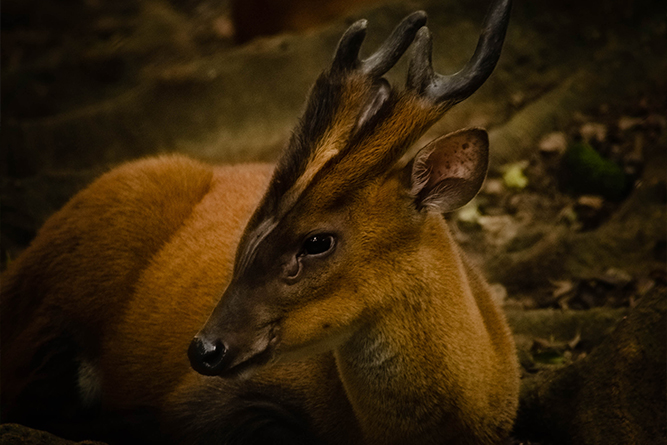The Bornean yellow muntjac is a captivating deer species that dwells in the lush rainforests of Borneo. Despite its unassuming appearance, this remarkable creature possesses a set of intriguing features that make it a true gem of the animal kingdom.
Table of Contents
Species Data
- Class: Mammalia
- Order: Artiodactyla
- Family: Cervidae
- Scientific Name: Muntiacus atherodes
- Life Span: Typically 10-15 years
- Height: Approximately 45-55 cm (18-22 inches)
- Weight: Around 11-18 kg (24-40 pounds)
Description
The Bornean yellow muntjac, scientifically known as Muntiacus atherodes, is a small and elusive deer species native to the rainforests of Borneo. Despite its name, its fur varies from reddish-brown to yellowish-brown, blending perfectly with the forest foliage. These deer are recognized by their small size and short, unbranched antlers.
Appearance
One of the distinctive features of the Bornean yellow muntjac is its compact size. It's among the smallest deer species globally, allowing it to navigate dense vegetation with ease. Their petite frame and reddish-brown coat provide excellent camouflage in the forest.
Behavior
Bornean yellow muntjacs are primarily solitary creatures, and they are known for their shy and secretive behavior. They are most active during dawn and dusk, relying on their keen senses, especially their acute hearing, to detect potential threats.
Habitat
These enchanting deer are exclusively found in the dense rainforests of Borneo. Their habitat preference is closely tied to areas with ample cover and a rich variety of plant life, which provides them with a diverse food supply.
Diet and Nutrition
Bornean yellow muntjacs are herbivores with a varied diet that includes leaves, fruits, and vegetation found in their rainforest habitat. Their feeding habits play a vital role in shaping the forest ecosystem.
Mating Habits
During the breeding season, which typically occurs from November to February, males establish territories and compete for the attention of females.
Mating Behavior
- Reproduction Season: Usually from November to February
- Pregnancy Duration: Approximately 6-7 months
- Baby Carrying: Does care for and protect their fawns
- Independent Age: Fawns become more independent at around 5-6 months
- Female Name: Doe
- Male Name: Buck
- Baby Name: Fawn
5 Fun Facts for Kids
- The Bornean yellow muntjac is often referred to as the “little barking deer” due to its distinctive vocalizations.
- Despite their small size, they are excellent jumpers and can clear obstacles with ease.
- Their antlers, while small, serve primarily for defense and territory marking.
- These deer are critical for seed dispersal in the rainforest, helping maintain plant diversity.
- Conservation efforts are vital to protect these secretive creatures and their precious rainforest habitat.
The Bornean yellow muntjac, though small, holds a unique place in the heart of Borneo's rich biodiversity.


